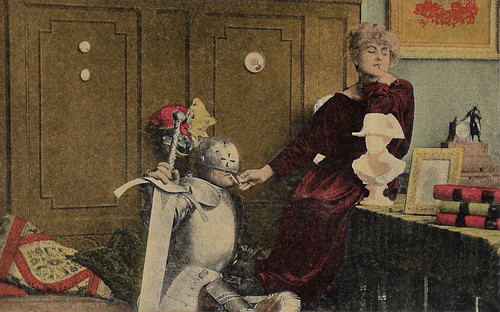Maria Corvin aka Mary Corwyn aka Mary Corwin and Maria Corvin (1895-?) was a Polish actress, active in Italian silent film.
Image may be NSFW.
Clik here to view.
Italian postcard by Ed. Società Anonima, Bettini, Roma, no. 265. Photo: Bettini, Roma.
Image may be NSFW.
Clik here to view.
Italian postcard by Ed. Società Anonima, Bettini, Roma, no. 267. Photo: Bettini, Roma.
Image may be NSFW.
Clik here to view.
Italian postcard by Ed. Società Anonima, Bettini, Roma, no. 268. Photo: Bettini, Roma.
Maria Corvin aka Mary Corwyn aka Mary Corwin was born Maria Breninski or Breninki in 1895 in Warsaw, Poland. Maria was widowed when she was a young girl. She arrived in Italy on a British ship and soon she was noted in Neapolitan literary circles.
In 1916 she was hired by the Neapolitan film company Polifilms, where she acted in seven films directed by Giulio Antamoro, and distributed by Lombardo Film. She became the 'first actress' at Polifilm, thanks to her blue eyes and photogenic qualities.
In 1918 journalist Edoardo Scarfoglio brought her to writer-producer-actor Lucio D'Ambra, who hired her for his Roman film company Do-Re-Mi. She debuted there in Napoleoncina/Napoleonette (Lucio D'Ambra, 1918), about a young girl smitten with Napoleon and his modern lookalike Dr. Toccasana. When she discovers her sister is in love with the doctor's nephew (Luigi Serventi), but the latter only has eyes for an affected American woman, she energetically chases the rival.
After four more films with Lucio D'Ambra, Corwyn returned to Naples for one more film, the Balzac adaptation Vautrin (Alexandre Devarennes, 1919), starring Giovanni Grasso and produced by Lombardo Film. She then returned to act in Il girotondo degli undici lancieri (Lucio d'Ambra, 1919), produced by the new company D'Ambra Films.
After two more films at Cines and Rosa Films, Maria Corvin left Italy in 1920. Nothing more is known of her, not even when and where she died.
Image may be NSFW.
Clik here to view.
Spanish cromos by Chocolat Imperiale, Barcelona, Card no. 1 of 6. Photo: Do-Re-Mi Film / Dist. J. Verdaguer, Barcelona. Maria Corvin in NapoleoncinaNapoleonette (Lucio D'Ambra, 1918). The Spanish title of the film was Napoleoncilla.
Image may be NSFW.
Clik here to view.
Spanish cromos by Chocolat Imperiale, Barcelona, Card no. 1 of 6. Photo: Do-Re-Mi Film / Dist. J. Verdaguer, Barcelona. Maria Corvin in Napoleoncina (Lucio D'Ambra, 1918). The Spanish title of the film was Napoleoncilla.
Image may be NSFW.
Clik here to view.
Spanish cromos by Chocolat Imperiale, Barcelona, Card no. 1 of 6. Photo: Do-Re-Mi Film / Dist. J. Verdaguer, Barcelona. Maria Corvin in Napoleoncina (Lucio D'Ambra, 1918). The Spanish title of the film was Napoleoncilla.
Sources: Vittorio Martinelli (Il cinema muto italiano - Italian), Wikipedia (Italian) and IMDb.
Image may be NSFW.
Clik here to view.

Italian postcard by Ed. Società Anonima, Bettini, Roma, no. 265. Photo: Bettini, Roma.
Image may be NSFW.
Clik here to view.

Italian postcard by Ed. Società Anonima, Bettini, Roma, no. 267. Photo: Bettini, Roma.
Image may be NSFW.
Clik here to view.

Italian postcard by Ed. Società Anonima, Bettini, Roma, no. 268. Photo: Bettini, Roma.
Her blue eyes and photogenic qualities
Maria Corvin aka Mary Corwyn aka Mary Corwin was born Maria Breninski or Breninki in 1895 in Warsaw, Poland. Maria was widowed when she was a young girl. She arrived in Italy on a British ship and soon she was noted in Neapolitan literary circles.
In 1916 she was hired by the Neapolitan film company Polifilms, where she acted in seven films directed by Giulio Antamoro, and distributed by Lombardo Film. She became the 'first actress' at Polifilm, thanks to her blue eyes and photogenic qualities.
In 1918 journalist Edoardo Scarfoglio brought her to writer-producer-actor Lucio D'Ambra, who hired her for his Roman film company Do-Re-Mi. She debuted there in Napoleoncina/Napoleonette (Lucio D'Ambra, 1918), about a young girl smitten with Napoleon and his modern lookalike Dr. Toccasana. When she discovers her sister is in love with the doctor's nephew (Luigi Serventi), but the latter only has eyes for an affected American woman, she energetically chases the rival.
After four more films with Lucio D'Ambra, Corwyn returned to Naples for one more film, the Balzac adaptation Vautrin (Alexandre Devarennes, 1919), starring Giovanni Grasso and produced by Lombardo Film. She then returned to act in Il girotondo degli undici lancieri (Lucio d'Ambra, 1919), produced by the new company D'Ambra Films.
After two more films at Cines and Rosa Films, Maria Corvin left Italy in 1920. Nothing more is known of her, not even when and where she died.
Image may be NSFW.
Clik here to view.

Spanish cromos by Chocolat Imperiale, Barcelona, Card no. 1 of 6. Photo: Do-Re-Mi Film / Dist. J. Verdaguer, Barcelona. Maria Corvin in NapoleoncinaNapoleonette (Lucio D'Ambra, 1918). The Spanish title of the film was Napoleoncilla.
Image may be NSFW.
Clik here to view.

Spanish cromos by Chocolat Imperiale, Barcelona, Card no. 1 of 6. Photo: Do-Re-Mi Film / Dist. J. Verdaguer, Barcelona. Maria Corvin in Napoleoncina (Lucio D'Ambra, 1918). The Spanish title of the film was Napoleoncilla.
Image may be NSFW.
Clik here to view.

Spanish cromos by Chocolat Imperiale, Barcelona, Card no. 1 of 6. Photo: Do-Re-Mi Film / Dist. J. Verdaguer, Barcelona. Maria Corvin in Napoleoncina (Lucio D'Ambra, 1918). The Spanish title of the film was Napoleoncilla.
Sources: Vittorio Martinelli (Il cinema muto italiano - Italian), Wikipedia (Italian) and IMDb.
